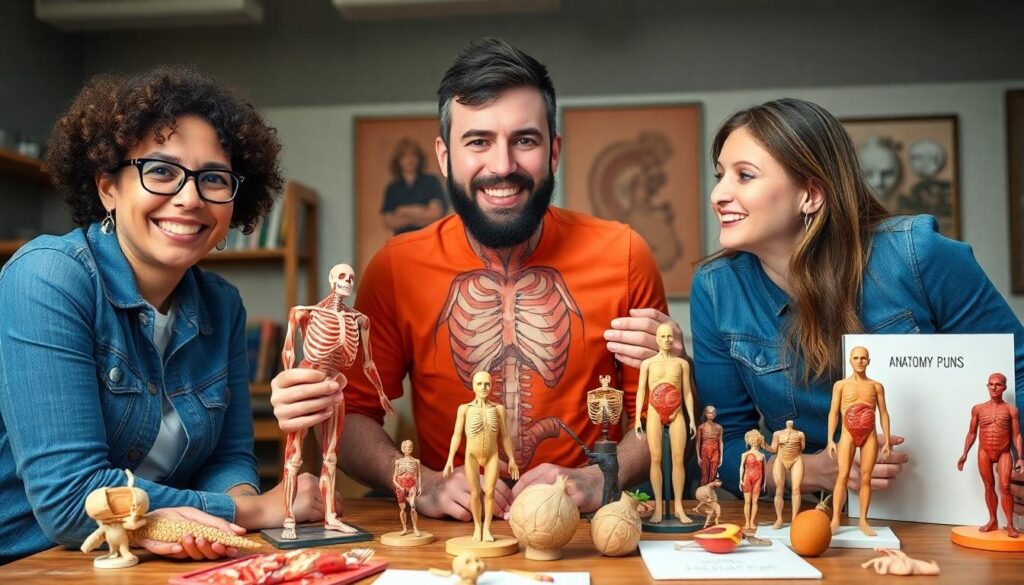Ready to bone up on your humor? We’ve got a skeleton of jokes that’ll have you in stitches! Anatomy puns are a spine-tingling way to flex your comedy muscles and show off your body of knowledge.
Whether you’re a medical professional looking to humerus up your day or just someone who gets a kick out of wordplay, these anatomy puns hit the funny bone every time. We’ve assembled a collection that covers every part of the body—from head to toe and everything in between. Trust us, they’re organ-ized for maximum laughs.
10 Bone-Tickling Anatomy Puns That Will Get Under Your Skin
- I found this humerus – We couldn’t resist starting with the classic bone pun! The humerus (upper arm bone) sounds just like “humorous,” making it the perfect anatomical wordplay that never gets old in medical circles.
- You’re tea-riffic, just my cup of tea-bia – Your tibia, located in your lower leg, makes for a wonderfully punny compliment when you want to tell someone they’re exactly what you’ve been looking for.
- I’ve got my ion you – Chemistry meets anatomy in this clever pun! Ions are crucial for nerve impulses and muscle contractions, so telling someone you’ve got your ion them means they’ve definitely caught your attention.
- That joke was so funny, I nearly split my sides-plexus – The solar plexus is a network of nerves behind your stomach, and this pun works perfectly when something has you laughing uncontrollably.
- You’re the apple of my oculi – Oculi refers to eyes in anatomical terms, making this a charming anatomical twist on the classic expression of affection that’s sure to make someone blush.
- I’d tell you a chemistry joke but all the good ones argon – While technically crossing into chemistry territory, this pun works well with discussions of noble gases in the bloodstream and respiratory function.
- Don’t be so teste – A playful twist referencing the testes that works as a punny way to tell someone not to be difficult or irritable. This one requires the right audience!
- You’re simply nerve-ending – Nerve endings are responsible for sensations throughout our body, making this a great compliment suggesting someone is absolutely sensational.
- I’m patella-ing everyone about your awesome joke – Your patella (kneecap) sounds remarkably similar to “telling,” creating a perfect opportunity for this skeletal wordplay.
- That was a spine-tingling experience – We’re wrapping up our list with this vertebral pun that works wonderfully when describing thrilling or exciting situations that give you goosebumps.
Why Anatomy Puns Are Good For Your Funny Bone

The Science Behind Why We Love Anatomical Humor
Anatomy puns actually trigger exact brain reactions that create pleasure. Research shows these wordplays activate the brain’s left inferior prefrontal cortex, which handles phonological processing, leading to dopamine release in our reward pathways. Functional MRI studies have revealed that semantic humor like anatomy jokes engages language-processing regions including the posterior temporal lobes. Women might enjoy these puns even more, as their dopamine-driven reward systems show heightened sensitivity to prosocial humor. The neural mechanisms behind puns explain why that skeleton joke made you laugh so hard—it’s literally stimulating your brain’s pleasure centers while lowering stress levels and fostering social connections.
How Anatomy Puns Help Medical Students Learn
Medical education benefits tremendously from incorporating humor into complex anatomical lessons. A 2024 study found that humor in anatomy lectures reduces anxiety, improves focus, and strengthens the rapport between students and teachers. Over 70% of medical professionals report using dark humor in labs as a coping mechanism for stress. These puns serve as powerful memory aids by creating unique associative learning cues that stick in students’ minds far better than dry terminology alone. Medical students who encounter phrases like “the humerus is humorous” are more likely to remember bone structures thanks to the emotional connection formed through wordplay. The educational benefits extend beyond mere entertainment, as humor fosters engagement and aids memory retention in what could otherwise be overwhelming anatomy courses.
Rib-Tickling Skeletal System Puns That Are Humerus

When it comes to anatomical humor, skeletal puns stand out as particularly entertaining. These bone-based jokes offer a perfect blend of education and entertainment for anatomy enthusiasts and casual jokesters alike.
Jokes About Bones That Won’t Leave You Numb-Skull
Bone puns have a way of connecting with people on a fundamental level. “Bone to be wild” serves as a classic example that playfully references our skeletal framework while nodding to a popular phrase. Many medical students remember the reassuring words “It’s going tibia ok” during stressful exam periods, cleverly incorporating the leg bone into a comforting message. Expressions like “I have a bone to pick with you,” delivered pointedly, merge everyday idioms with skeletal terminology for maximum comedic effect. Celebratory moments often call for a hearty “Hip Hip Hooray,” which doubles as a nod to our important hip joints. Romantic anatomy enthusiasts might confess “I knee-d you” to express their affection while incorporating joint humor. These skeletal jokes work because they tap into familiar body parts we all share, making the humor universally accessible.
Spine-Tingling Vertebrae Wordplay
Vertebrae puns form the backbone of any good anatomy joke collection. “I’ve got your back” works brilliantly as both a supportive statement and a literal reference to spinal anatomy. Exciting discoveries in anatomy class might prompt someone to exclaim “This is spine-tingling!” combining physical structure with emotional response. Tom Swifties elevate this humor with lines such as “I’ll dissect this Anatomy joke,” said heartlessly, which cleverly juxtaposes body parts with adverbial punchlines. Spine-related wordplay remains particularly effective because our vertebral column connects so many bodily systems, creating fertile ground for intersectional humor that experts and novices can appreciate. Medical educators frequently employ these puns to help students remember the complex structure of the spinal column, demonstrating how humor serves both entertainment and educational purposes in anatomical contexts.
Heart-Stopping Cardiovascular System Jokes

Cardiovascular humor takes aim at the heart and blood vessels with precision and wit. These anatomical jokes leverage the rich terminology of our circulatory system to create puns that both medical professionals and humor enthusiasts can appreciate.
Puns That Get The Blood Pumping
Cardiac puns frequently employ anatomical terminology to create wordplay that’s both educational and entertaining. “You’re so vein!” works as a clever twist on vanity while referencing vascular structures. When you need to apologize with anatomical flair, try saying “I’m aorta-fully sorry!” – a pun utilizing the body’s largest artery. For those with cold personalities, the term “Iceolated heart” combines thermal references with cardiovascular isolation.
Rhythm-related humor dominates cardiologist-centric jokes, connecting musical timing with heartbeats. “Why was the cardiologist a great musician? He had good rhythm” demonstrates this dual reference perfectly. Romance gets a cardiac twist with lines like “Our love story is an open-heart book,” blending surgical metaphors with emotional vulnerability. We especially love the advice to “Follow your heart, but don’t forget to check your pulse” – a perfect marriage of motivational speaking and medical monitoring.
Cardiac Humor That Won’t Skip A Beat
Medical profession-exact quips about the heart create humor that resonates with healthcare workers and patients alike. “Why did the heart break up with the brain? It needed space to beat” offers anatomical relationship satire that anyone can understand. Heart valves become the foundation for emotional wordplay in “Why are hearts good at secrets? They valve their emotions.”
Cardiovascular terminology provides rich material for puns, incorporating terms like ventricles, arteries, and bypass into clever jokes. One standout example combines metaphorical courage with literal consequences: “He had a heart of lion… and a zoo ban.” These jokes work particularly well in medical settings, where stress relief through humor can be especially valuable. Their effectiveness comes from blending technical accuracy with accessible humor, making them appropriate for both clinical environments and casual conversation.
Brain-Teasing Nervous System Wordplay

The nervous system provides fertile ground for some of the most stimulating anatomy puns. These wordplays tap into our understanding of neural pathways and sensory experiences to create humor that’s truly mind-bending.
Nerve-Racking Jokes That Hit A Nerve
Nervous system puns often strike a chord by playfully referencing our body’s reaction to stress and stimuli. “I have a bone to pick with you,” he said pointedly, exemplifies how these jokes create tension through anatomical references. “This is getting under my skin,” she said irritably, perfectly captures the frustration we feel when something bothers us, while connecting it to sensory nerves. These puns work because they reference both emotional states and physical sensations simultaneously.
The pressure-sensitive nerves throughout our body inspire jokes like “I’m feeling the pressure,” she said dramatically, which plays on both physical and emotional pressure. Another clever example is “Stop gall-bladder-ing about it!” which transforms an organ’s name into a verb representing anxious behavior. These nerve-racking jokes effectively use our understanding of the body’s stress responses to create humor that resonates with everyone who’s ever felt on edge.
Mind-Blowing Cerebral Humor
The brain’s complexity makes it perfect for sophisticated wordplay. “Heart to heart, anatomy’s an art!” demonstrates how cerebral humor often connects different body systems to create intellectual jokes. This type of pun appeals to those who appreciate the artistry of human anatomy. “I’ll dissect this Anatomy joke,” he said heartlessly, cleverly combines medical procedures with emotional states.
Visual processing centers in our brain inspire puns like “I’ve got an eye-dea!” which merges sensory organs with cognitive functions. For predictive reassurance, nothing beats “It’s going tibia ok” – a pun that crosses skeletal references with neurological comfort responses. These brain-focused jokes typically require more knowledge to appreciate, making them especially popular among medical students and healthcare professionals who understand the intricate connections between our thoughts, sensations, and anatomical structures.
Tom Swifties represent a common technique in nervous system wordplay, where adverb-based punchlines create neural connections between speech and manner. Homophones like “humerus” versus “humorous” trigger multiple processing centers in the brain, improving the joke’s impact through linguistic cleverness.
Breathtaking Respiratory System Puns

Taking a deep jump into respiratory humor is sure to inflate your mood and oxygenate your funny bone. Our collection of airway-inspired wordplay will have you gasping with laughter!
Lung-Inflating Jokes That Won’t Leave You Breathless
Respiratory humor truly expands our capacity for laughter with clever wordplay. “I can’t inhale without you!” works perfectly as a nose-to-lung declaration of affection. Medical professionals often share gems like “Did the bronchitis win the race? It was a real cough-up!” cleverly merging pathology with humor that resonates in hospital corridors.
Lungs make surprisingly versatile comedy subjects with puns about their musical preferences: “What’s a lung’s favorite music? Breath-taking tracks!” Music continues as a theme with “Why did the lung join the band? To play the air-guitar!” demonstrating how respiratory organs inspire multilayered jokes. Personification adds another dimension with quips like “I’m on cloud nine… of oxygen!” expressing a lung’s euphoric state.
Security-minded individuals might appreciate “Lungs make terrible secret agents – they can’t keep a breath-thing quiet!” This espionage-themed humor connects respiratory function to an unexpected context, creating a surprising punchline that works on multiple levels.
Air-Way Funny Diaphragm Wordplay
Diaphragm jokes require precise timing, much like breathing itself. “I tried a diaphragm joke, but it fell flat” offers meta-commentary on comedic airflow that respiratory therapists particularly appreciate. Healthcare professionals regularly share workplace humor like “Why do respiratory therapists document lightbulb changes? For medical records!” which satirizes the extensive paperwork in medical settings.
Respiratory therapists face unique challenges daily, reflected in frank observations such as “You might think it’s easy, but it’s SNOT” – combining nasal humor with workplace reality. These professional-focused puns acknowledge the complexity of respiratory care while finding levity in daily challenges.
Our respiratory system runs on air and puns, providing endless inspiration for those who appreciate anatomical humor combined with clever wordplay. Double meanings, personification of body parts, and workplace satire create a rich industry of respiratory comedy that resonates with both medical professionals and humor enthusiasts alike.
Gut-Busting Digestive System Humor

Our digestive system offers a feast of punny possibilities that are sure to satisfy your hunger for humor. From the esophagus to the intestines, these anatomical jokes will have you holding your sides—literally!
Stomach-Churning Puns You Can’t Digest
“I can’t stomach this drama” perfectly captures both emotional overwhelm and digestive anatomy in one clever phrase. Many medical students find themselves “feeling really rib-tickled” during their first anatomy labs, creating an instant connection between humor and learning. “I’ve got your back” works brilliantly as both a supportive statement and a spinal reference that resonates with anyone who’s experienced vertebral challenges. Joint humor surfaces in phrases like “I’m all about the joints,” which appeals to both anatomy enthusiasts and those seeking double meanings. People often struggle when someone tells them to “stop gall-bladdering about it,” merging gallbladder anatomy with impatience in a digestively delightful way.
Liver-Loving Jokes That Bile You Over
“I am a liver, not a hater” stands as a prime example of organ-based wordplay that works on multiple levels. Orthopedists particularly enjoy telling patients “I’m trying to stay grounded,” said firmly—a subtle nod to the femur bone through clever homophone usage. Cardiologists often open serious conversations with “heart to heart, anatomy’s an art,” creating a comfortable atmosphere through cardiovascular wordplay. Medical instructors frequently remind students to “keep calm and study anatomy” when facing challenging digestive system concepts. The pinnacle of digestive humor appears in clever dialogue like “I’ll dissect this joke,” he said heartlessly—combining procedural terminology with cardiac references for maximum impact. When feeling under the weather, many patients admit their condition “sinus-ly,” cleverly connecting respiratory and digestive discomfort through anatomical wordplay.
Muscle-Flexing Puns For Fitness Enthusiasts

Looking to add some humor to your workout routine? These muscle-related puns will strengthen your funny bone while you’re strengthening everything else.
Bicep-Building Humor To Pump You Up
Flexing your comedy muscles can be just as satisfying as showing off your physical gains. “I’m just a muscle man,” he said flexibly, is the perfect icebreaker at the gym when you’re trying to make friends between sets. Fitness enthusiasts appreciate anatomical wordplay that references their dedication to strength training. “I’m all about the joints,” he said articulately, works as both a clever reference to your skeletal connections and a witty demonstration of verbal dexterity. These puns create an instant connection with fellow gym-goers who understand the daily grind of building muscle and maintaining proper form. “This anatomy class is a real workout,” she said exhaustedly, perfectly captures the intensive nature of both physical training and learning human anatomy.
Core-Strengthening Jokes That Work Out Your Abs
Nothing builds core strength like a good laugh that engages your abdominal muscles. “I can’t stop laughing,” she said uncontrollably, is both a statement and a genuine reaction to good anatomy humor. Your abs get a real workout with these rib-tickling jokes that target the midsection. “I’m feeling really rib-tickled today,” she said with a laugh, demonstrates how anatomy puns can literally make you feel the humor in your body. Core-focused puns are particularly effective because they connect mental amusement with physical sensation. “I’m trying to stay grounded,” he said firmly, works as both a reference to core stability exercises and the mental focus required for fitness success. These jokes provide a momentary rest between sets while still keeping your mind engaged with the workout process.
How To Incorporate Anatomy Puns Into Everyday Conversation

Start with Context
Anatomy puns work best when they’re introduced in relevant situations. Medical discussions, fitness conversations, or health-related topics provide the perfect backdrop for slipping in a bone-related joke. Try using a simple line like “I’ve got a bone to pick with you” during a friendly debate, or mention how someone has a “bone-afide fascination” with a particular topic. These contextual introductions ensure your puns land without feeling forced.
Combine with Common Phrases
Integrating anatomical terms into everyday expressions creates memorable wordplay that’s both clever and accessible. Transform familiar idioms by adding body parts—instead of saying “I’m listening,” try “I’m all ears” to give a standard phrase an anatomical twist. Another approach involves blending body systems, such as “I’ve got a bone to pick with my heart,” which combines skeletal and cardiovascular references for double the humor. This technique works especially well in casual conversations where unexpected wordplay catches listeners off guard.
Create a Lighter Atmosphere
Anatomy puns serve as excellent tension breakers during serious discussions. Medical professionals often use phrases like “Don’t be so vein” or “Iris my case” to lighten the mood when explaining complex conditions to patients. These humorous interjections help reduce anxiety in stressful situations while maintaining professionalism. Research shows that appropriate humor in medical settings can significantly improve patient-provider relationships and create a more comfortable environment.
Be Creative
Developing your own unique anatomy puns keeps conversations fresh and captivating. Start by picking different body parts and brainstorming related words that have multiple meanings. Heart puns like “I lung for you every time we’re apart” play on emotional connections, while vision-related jokes such as “These puns are eye-mazing” use visual terminology. Muscle puns offer another rich territory with lines like “Flex your brain muscle with some anatomy wit!” The more you practice creating these puns, the more naturally they’ll flow in your everyday conversations.
The Best Anatomy Puns To Break The Ice At Medical Conferences
Anatomy puns aren’t just entertaining—they’re a powerful tool for learning medical concepts while keeping things light-hearted. From skeleton jokes that tickle your funny bone to cardiovascular quips that get hearts racing these wordplays create connections between complex terminology and everyday humor.
We’ve seen how these puns activate pleasure centers in our brains releasing dopamine and reducing stress. They’re especially valuable in medical education where they help students remember complicated structures through emotional associations.
Next time you’re struggling with anatomical terms try incorporating a pun or two. Whether you’re a medical professional fitness enthusiast or just someone who appreciates clever wordplay there’s an anatomy joke that’ll hit just the right nerve. Remember it’s all about finding the perfect balance between education and entertainment—that’s the heart of a truly successful anatomy pun!
Frequently Asked Questions
What are anatomy puns?
Anatomy puns are wordplay jokes that use anatomical terms and body parts as the basis for humor. They combine medical terminology with everyday expressions to create clever, often groan-worthy jokes like “I found this humerus” (playing on “humorous” and the arm bone) or “You’re tea-riffic, just my cup of tea-bia” (referencing the tibia bone in the leg).
Why do people enjoy anatomy puns?
People enjoy anatomy puns because they activate pleasure centers in the brain and trigger dopamine release, reducing stress. They create a cognitive connection between technical knowledge and humor, making complex information more accessible. Studies show these puns can improve mood and provide a social bonding experience, particularly among medical professionals who share the specialized knowledge needed to understand them.
Do anatomy puns help with medical education?
Yes, anatomy puns significantly enhance medical education. They reduce classroom anxiety, improve focus, and strengthen student-teacher rapport. A 2024 study found that humor in anatomy lectures serves as a powerful memory aid, helping students retain complex information through emotional connections. When students associate anatomical structures with clever wordplay, they’re more likely to remember them during exams.
What are some examples of skeletal system puns?
Popular skeletal system puns include “Bone to be wild,” “It’s going tibia ok,” “I found this humerus,” and “I’m patella-ing everyone about your awesome joke.” These puns cleverly incorporate bone names like the tibia, humerus, and patella into everyday phrases, making them both educational and entertaining for medical students and casual jokesters alike.
Are there puns specific to the cardiovascular system?
Yes, cardiovascular system puns include gems like “You’re so vein!” (playing on “vain”), “I’m aorta-fully sorry!” (referencing the aorta), and rhythm-related jokes like “Why was the cardiologist a great musician? He had good rhythm.” These puns connect heart and blood vessel terminology with common expressions, providing both entertainment and educational value.
How can nervous system puns be used in conversation?
Nervous system puns like “I have a bone to pick with you” and “This is getting under my skin” connect emotional states with physical sensations. More cerebral examples include “Heart to heart, anatomy’s an art!” These can be strategically used to lighten tense situations, particularly in medical settings, or to demonstrate knowledge in an engaging way during anatomy discussions.
What makes respiratory system puns unique?
Respiratory system puns uniquely blend breathing processes with humor, featuring jokes like “I can’t inhale without you!” and “Did the bronchitis win the race? It was a real cough-up!” They include musical references (“What’s a lung’s favorite music? Breath-taking tracks!”) and workplace humor relevant to respiratory therapists. Their versatility makes them popular among both medical professionals and humor enthusiasts.
How can I incorporate anatomy puns into everyday conversation?
Start with context by introducing puns in relevant situations. Combine anatomical terms with common phrases for memorable wordplay, like turning “I’ve got your back” into a vertebrae joke. Use humor to create a lighter atmosphere, especially in medical settings. Practice developing unique puns that flow naturally in conversation, and don’t be afraid to get creative with your wordplay.
Do different genders appreciate anatomy puns differently?
Research suggests women may particularly enjoy anatomy puns due to their heightened sensitivity to prosocial humor. While appreciation of humor is highly individual, studies indicate that women often respond more positively to wordplay that creates social connections and shared understanding. However, well-crafted anatomy puns can be enjoyed by anyone with an appreciation for clever wordplay, regardless of gender.
Can digestive system puns be appropriate in professional settings?
Digestive system puns can be appropriate in professional settings when used tastefully and contextually. Jokes like “I can’t stomach this drama” can lighten tense situations, while more technical puns may facilitate learning in medical education. The key is reading your audience and environment—medical conferences and healthcare settings often welcome such humor, while formal business meetings might not be the best venue.







